Fritillaria imperialis: Time to Plant Pineapple Lilies

I wish it hadn’t taken me so long to grow Fritillaria imperialis. I guess I thought these exotic-looking flowers would be difficult. But now I know: exotic they are, difficult they’re not. Here are a few things I have learned about growing Fritillaria imperialis, which are also called crown imperials.
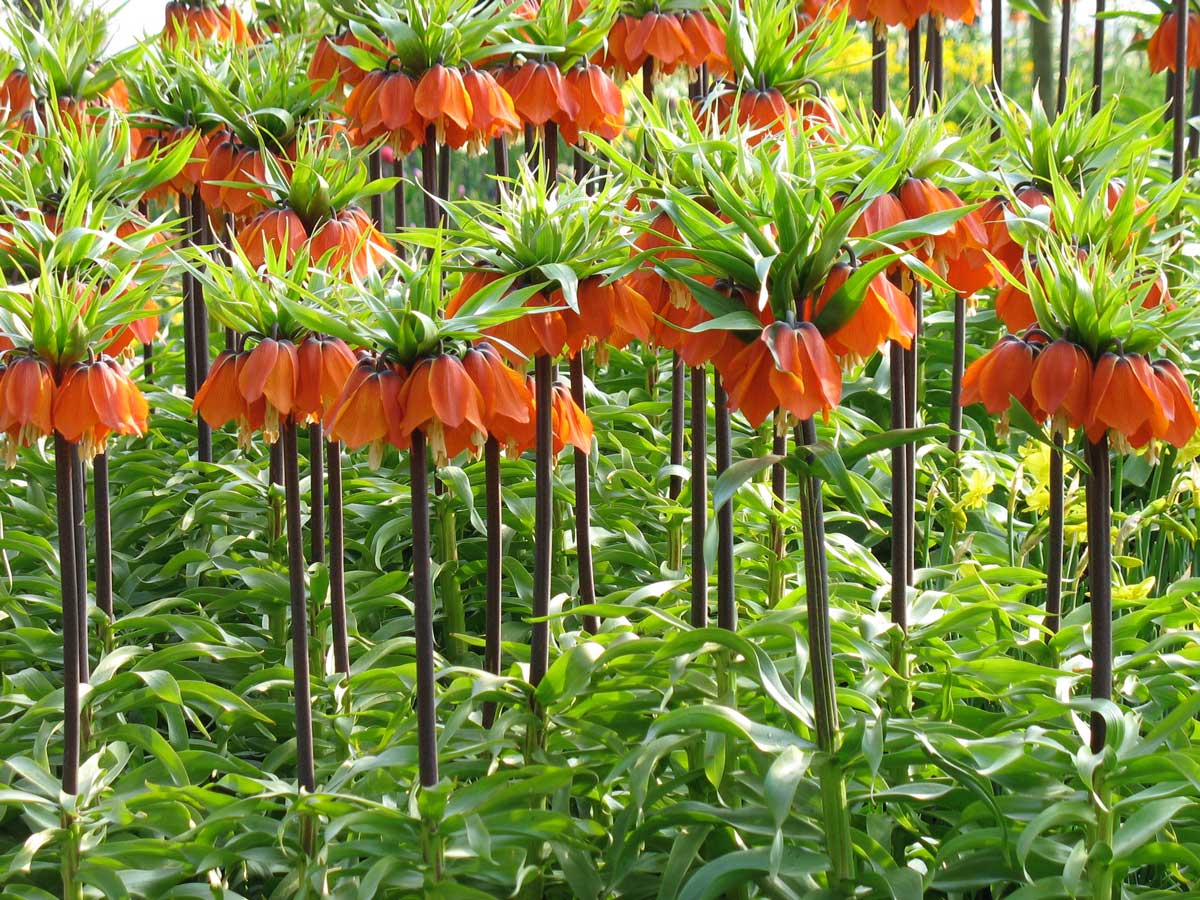
What to Know About Fritillaria Imperialis
All fritillarias are members of the lily family. Though the flowers look very different, their foliage is actually quite similar. Like lilies, the plants don’t have branches. The glossy leaves of fritillaria imperialis encircle the main stem and are attached directly to it. Additional leaves form a topknot above the flowers.
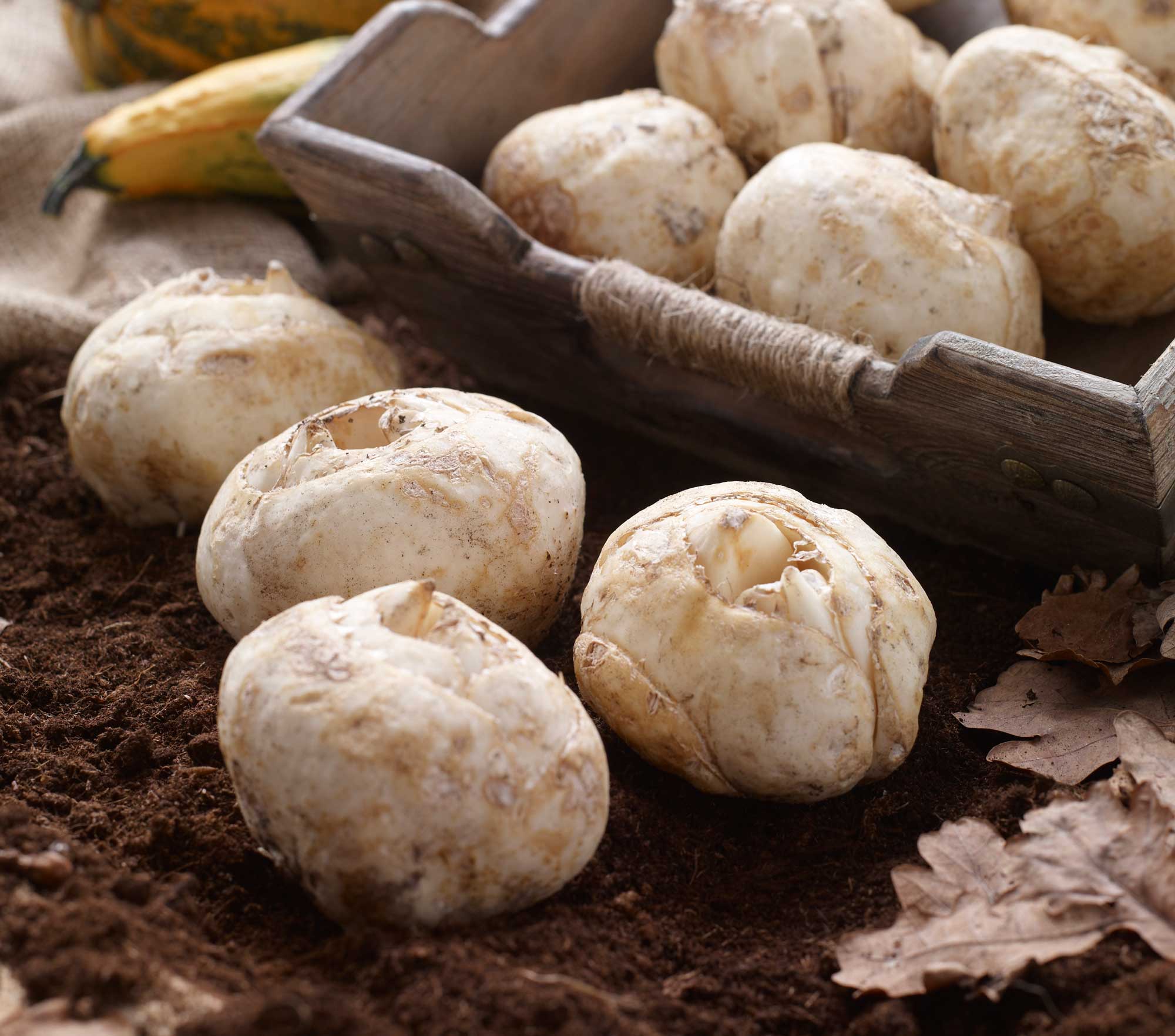
Fritillaria bulbs have scales like lily bulbs, but their scales are fused rather than being separate. The bulbs are more than twice the size of a regular lily bulb and much heavier. When handling them, you will notice they have a peculiar smell. In fact, all parts of the plant emit this same slightly skunky odor. This is what makes Fritillaria imperialis distasteful to garden pests including rabbits, voles, squirrels and deer.
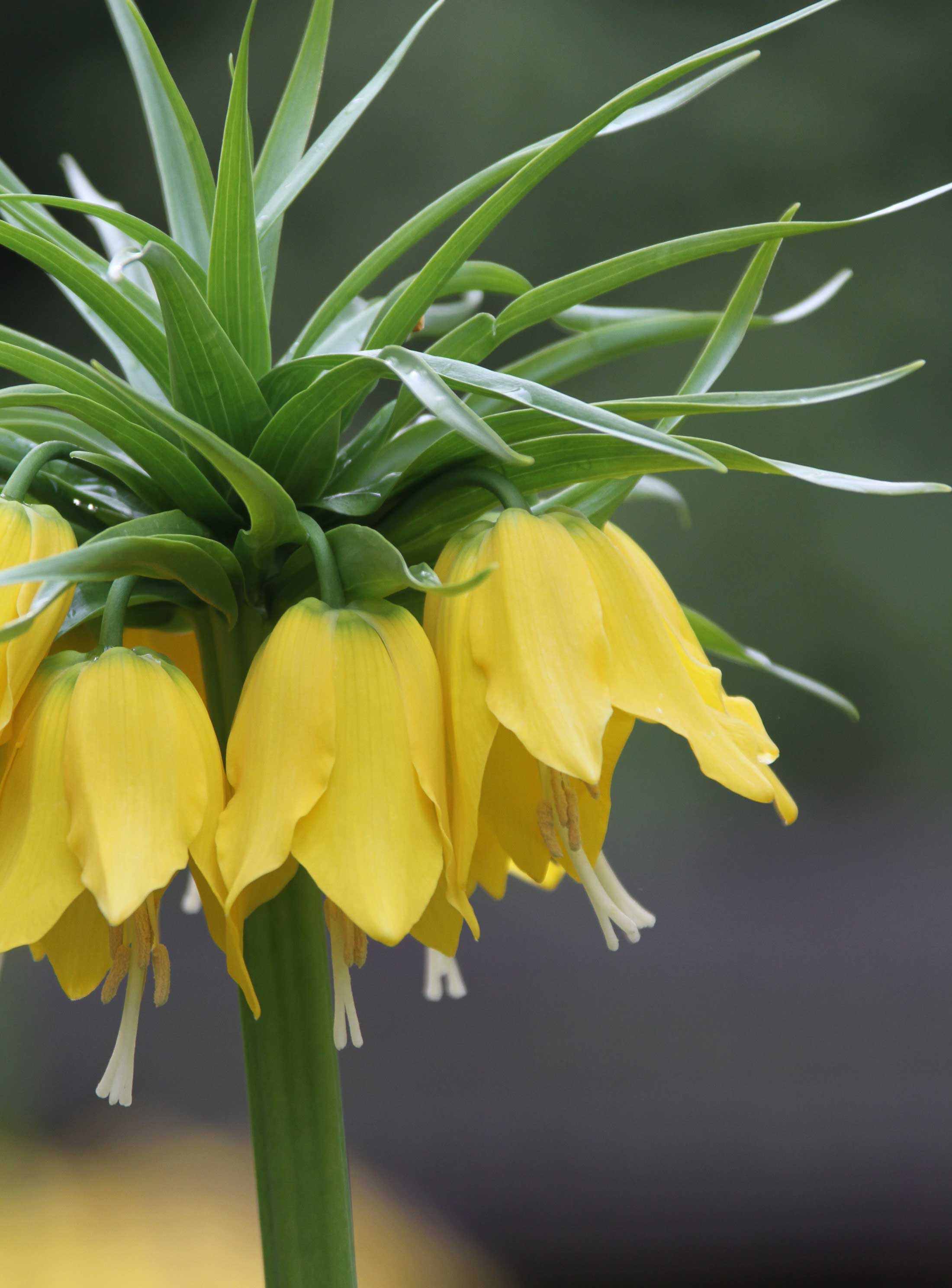
Spring Flowers That Always Get Noticed
Of course the most distinctive thing about Fritillaria imperialis is the flowers. Each bulb produces one perfectly straight, glossy black stem. On top is a crown of bell-like flowers and a crazy hairdo of spiky foliage. Though the plants aren’t particularly tall (30-36″), their unusual appearance makes them an un-missable feature in the garden.
The two most commonly available varieties of Fritillaria imperialis are Rubra maxima, with orange flowers, and Lutea maxima, with bright yellow flowers. Both of them bloom in mid-spring, toward the end of peak daffodil season. Every part of the show is entertaining — from earliest bud to full bloom. Their long-lasting flowers guarantee weeks of enjoyment.
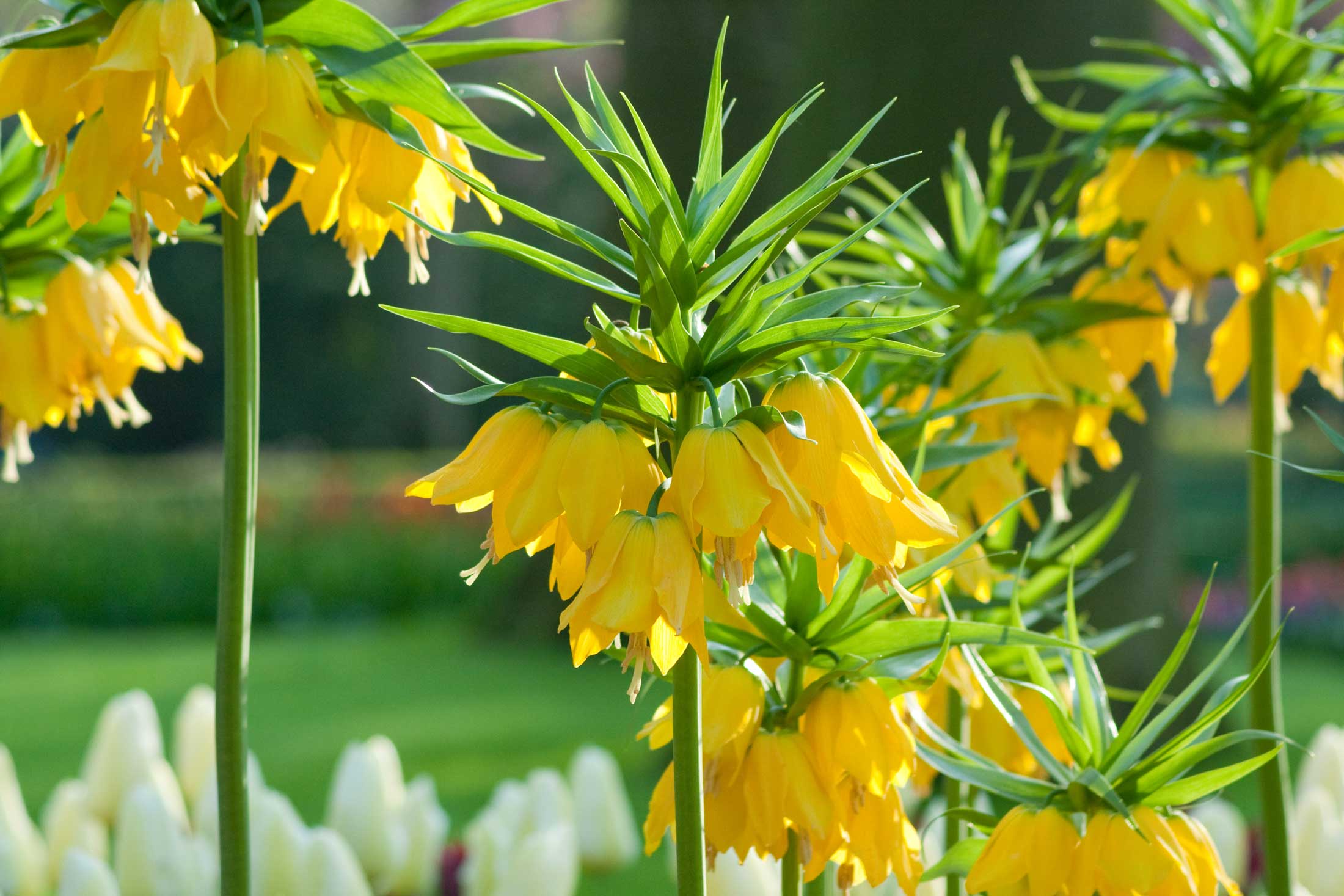
Fritillaries have a reputation for being more finicky than other fall-planted bulbs. Here’s how to keep them happy:
Plant the Bulbs in Well Drained Soil
Fritillaria bulbs are susceptible to rot, so it’s particularly important to plant them in well drained soil. As a precaution, you can dig a slightly deeper hole and put a shovelful of sand under the bulb. Another option is to plant the bulb on its side so water is less likely to collect in the hole on the top of the bulb. When the stem emerges in spring, it will head for the sun and grow just as straight as if you had planted the bulb upright.
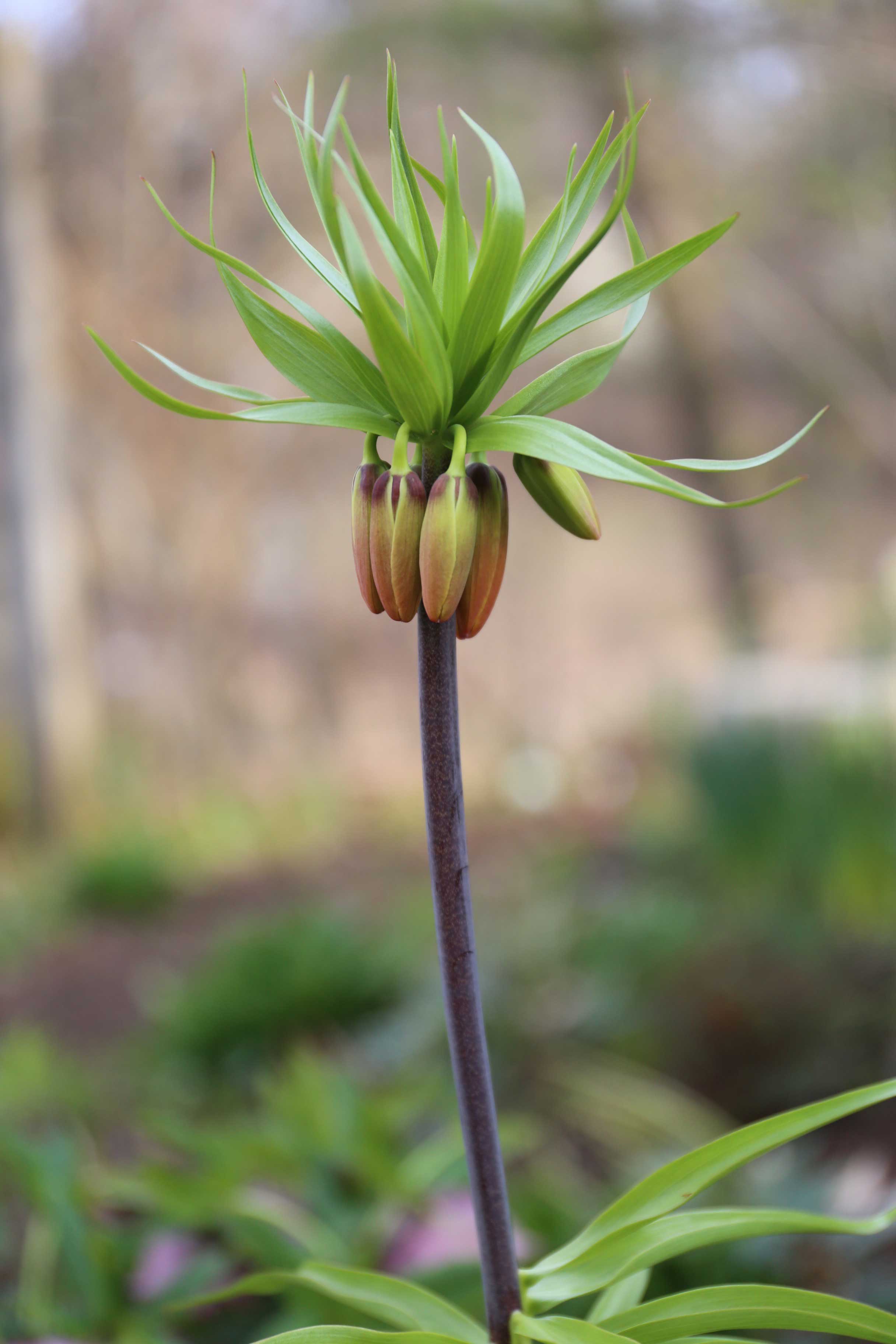
Give the Plants a Warm, Sunny Spot
Fritillaria imperialis prefers full sun. As with most spring-blooming bulbs, the plants will also grow in partial shade, but full sun will give them the best chance of returning with a second year of flowers.
Ideally, crown imperial bulbs should spend the summer in soil that is warm and dry. They want the same semi-arid growing conditions of their native habitat in Afghanistan, Turkey, Iran, Iraq and Pakistan. The soil in my garden couldn’t be more different. It’s cold and wet almost all year-round.
Fritillaria imperialis is rated as winter hardy in zones 5 and warmer. I have found them to be winter hardy in zone 4B, but the plants don’t come back reliably. That may be a function of the cold, but more likely the wet. So I replant a few fresh bulbs each fall, just as I do with tulips.

Plant the Bulbs in Early Fall
While most fall-planted bulbs have a protective covering (called a tunic) that helps prevent moisture loss, lily and fritillaria bulbs are naked. This makes them more perishable, so the less time the bulbs out of the ground the better. Purchase fresh, properly stored bulbs as soon as they are available, and get them planted by mid-October.
Some Fine Print About Fritillaria Imperialis
Though these bulbs are rarely bothered by deer or rodents, as members of the lily family, they are vulnerable to the red lily leaf beetle. If these pests are a problem in your area, you’ll need to control them. Fortunately, the foliage only needs to be protected until it dies back to the ground, which happens about a month after flowering.
Here’s one other thing to know about growing fritillaria. In any given batch of bulbs, a percentage of them tend to be “blind.” These are bulbs that come up and produce foliage, but do not produce a flower. This behavior is somewhat of a horticultural mystery. It’s not about the size of the bulbs. Just an annoying characteristic of the species. Since there’s no way to know ahead of time which bulbs will not bloom, plant a couple extras so you’re not disappointed.
For additional information about growing Fritillaria imperalis, you may want to read our article: All About Fritillaria. To see our complete selection of fritillaria, click HERE.

These are very pretty & I don’t think I have ever seen these before. Will these plants grow well incontainers? I do a lot of my plants in containers. If so, how many bulbs count you plants in one container? I know it would probably depend on the size of the container, but say for a 12″ pot? Only one per pot, or more?
Hi Angie – If you are able to grow tulips in containers, you can treat fritillaria imperialis the same way. I would not put more than one bulb in a 12″ container. Each bulb produces a flower cluster that’s about 12″ across, so you’ll want to give each bulb plenty of space to show off.
I too have fallen in love with this beautiful flower! I have planned about four in the garden but only one produces a beautiful show, the other three are duds. Should I dig those out or will they eventually produce a flower?
Hi Olya – These fritillaries are quirky. Some percentage of the bulbs are always “blind” and do not bloom. At planting time, it is impossible to tell which ones will bloom and which ones won’t. This is frustrating and we have considered not offering them to avoid disappointing our customers. But when they do bloom, they are wonderful! I always plant a few more bulbs each fall, so am never quite sure if it’s the old ones that bloom or the new ones.
Do the flowers smell bad?
If so can you smell them from a far?
Hi Karina – It’s the bulb and the plant itself that have a slightly skunky odor. I honestly have never smelled the flowers up close, but I know florists sometimes use them in arrangements, so they can’t smell too badly. I have a very sensitive sense of smell and occasionally I can smell the plants when I’m near them, but mostly not. The plants are only around for 4-6 weeks because they come up, bloom and then die back. They’re such cool flowers!
Hi:
Riz Reyes suggested your site.
I’m new to planting commercial containers and want to put 3-5 of these in a 24″ container with a dracaena and a blue Juniperus horizontalis. Would you mind naming a few plants these combine well with?
Thanks!
Hi Cindy – Are you looking for recommendations for other spring-blooming bulbs? If so, Fritillaria imperialis look beautiful with all of them. It is difficult to perfectly coordinate time of bloom, but in a container I would suggest pairing these bulbs with low-growing mid-season tulips or daffodils (full size varieties sometimes get a little floppy in containers). You don’t say if you have chosen the yellow or the orange, but consider a relatively early, long-blooming daffodil such as Tete a Tete or Jetfire and early double tulips such as Monsella or Monte Orange.
What is a common name for them
Hi – The common name I’ve heard is crown imperial.
I got my bulbs in February here in KY. Should I plant them in early spring or keep them refrigerated till early fall, to plant?
Hi David – Fritillaria bulbs should be planted in early fall. They are very perishable. If the bulbs are still firm and solid (like a potato) when spring comes, plant them immediately.
Hello, I’m in the UK and planted my bulbs at the beginning of November. I was just wondering when they’re likely to start coming through as I haven’t seen any signs of life yet? Thanks
Hi Laura – Fritillaria usually bloom about the same time as hyacinths. The plants grow very quickly once they emerge from the soil. The stems and foliage look similar to those of a lily. Good luck!
Hi , I have bought some of these bulbs but need to know if it’s ok to plant in April ? Or should I store them until sept and plant then ?
Hi – Fritillaria imperialis is a fall-planted bulb. If you have purchased bulbs now (in spring), it’s unlikely they are still viable as they would have been harvested last summer. You can go ahead and plant the bulbs now and see if they grow. If you want flowers next spring, we recommend purchasing fresh bulbs in the fall and planting them immediately.
I’ve just seen a piece on these flowers on Gardener’s World and apparently they’re pollinated by blue tits – thought this was worth a mention.
What should I do with them once they have flowered and died back in the pots?
If you want to see if the bulbs will bloom again next spring, cut off the flowers right after they fade. Leave the stem and foliage intact. Plant the bulb immediately, following the planting instructions provided in the article as to drainage and sun. Give the plant a little liquid fertilizer. If the foliage is able to produce enough nutrients before it dies back, the bulb may have enough strength to flower again next year.
I was really looking forward to seeing these bloom on a sunny hillside in my garden. I planted 10 bulbs. They came up beautifully and fast. Of the 10 only one bloomed. very disappointing. The foliage is great but not what I was hoping for. 90% duds….that’s definitely not great odds. It’s a lot of work preparing holes with adequate drainage and then waiting all fall and winter, only to have them do a no show.. I will probably not use them again given the high risk factor.
Hi Syd – I garden in Vermont (zone 4 with relatively heavy, wet soil) and find that most fritillarias are unreliable, even the first year after planting. But gardeners in some areas do very well with them. It’s hard to see a plant flourishing somewhere else and not want to have it in your own garden. But planting something new is always a bit of a gamble. Fortunately many other plants grow beautifully here. Hopefully that’s true where you are as well. 🙂
I saw the piece on crown imperials on Gardener’s World. Monty Don showed how to plant them. Then on a later episode you see Monty with them in full bloom. No mention of the possibility of blind bulbs. That rather major characteristic of the plant should be given a mention when selling or extolling it’s other virtues.
Hy Syd – Maybe these bulbs are more reliable in the British Isles? Here in the US, the blind bulb problem is unfortunately a reality, so we feel it’s important to let people know it may be the bulbs and not them.
I have some of these that my neighbor gave me from her yard.
They bloomed orange every year in her yard.
When I planted them in my yard, they never reach full height or bloom.
They grow about 12″ then the leaves start to fade to a pale yellow, they then wilt, fall over and die. But they keep coming back each year, I have them in an area where they get 3/4 of the day’s sunlight.
The soil is near pine trees and hemlocks. not sure what to do?
Any advice?
Hi – Fritillaria imperialis can be a bit tricky to grow. The divisions you received may be too small to bloom. Consider ordering some bulbs for fall planting and see if they perform better. The bulbs should produce stems that are 18-30″ tall, with stalks that are about an inch thick. I’m also thinking the soil may be a problem. The soil under evergreens is too acidic for many types of plants. Also note that even more so than other bulbs, this type of Fritillaria must be grown in soil with excellent drainage.